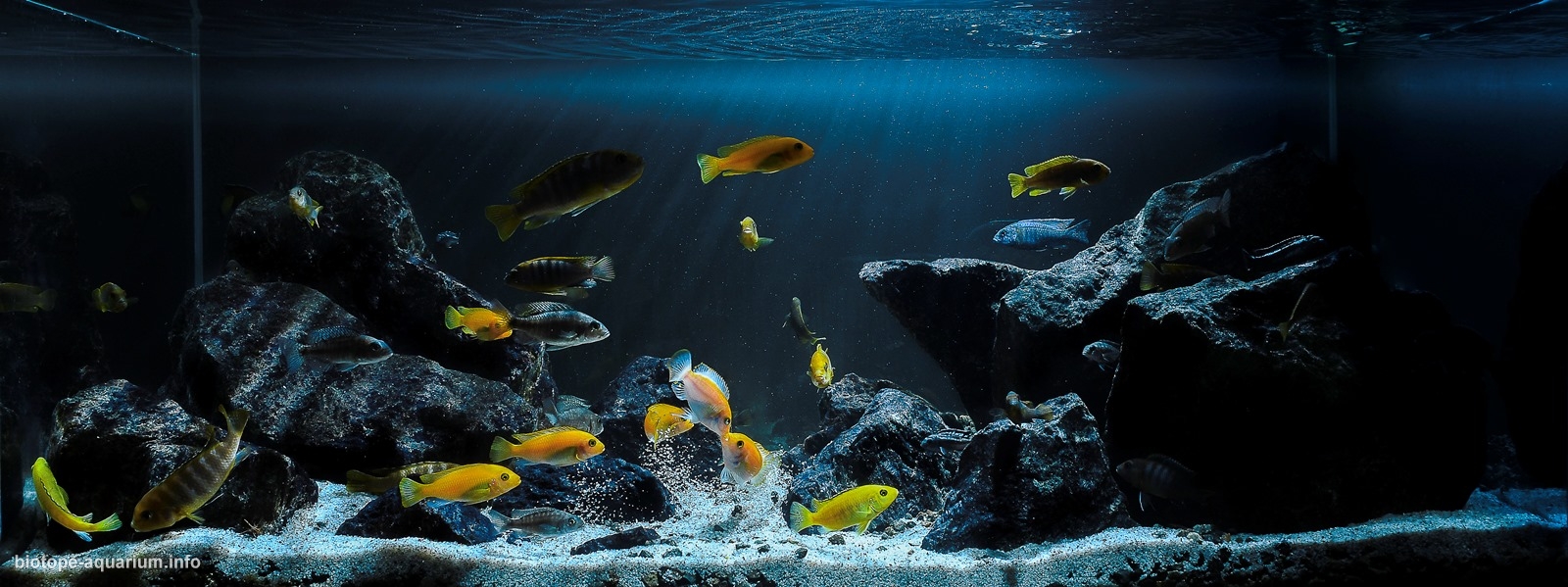The northeastern part of Lake Malawi (Tanzania) in the waters between Lundo Island
_th place in Biotope Aquarium Design Contest 2020

Volume: 250L
Dimensions: 1000*50*50
List of fishes: Aulonocara stuartgranti “Sanga”, Labidochromis sp. ‘Hongi’, Iodotropheus sprengerae, Labidochromis caeruleus var. “Yellow”, Melanochromis cyaneorhabdos, Pseudotropheus zebra Red
List of plants: None
Description of decorations: granite boulders, soil fraction – granite sand, 0.5-2 mm
Description of equipment: from equipment:
2 pcs External Filter , Eheim Professionel 3e 450, 1500 l / h, SunSun JVP-102A flow pump, light Ptero Ray 5950 / 90-100 63W lamp
Water parameters: GH 22, KH 10, pH 8,2, t- 24C
Additional info: a weekly thirty percent water change
INFORMATION ABOUT BIOTOPE:
Description of the area surrounding the biotope: The ninth largest in the world, Lake Malawi is about 600 km long and up to 80 km wide. The maximum depth is 700 meters, the height above sea level is 472 meters, the water surface area is approximately 31,000 square meters. km. The average water surface temperature in the lake ranges from 23 to 28 C. Seasonal fluctuations in temperature and precipitation directly affect the transparency of the water: if on a hot February day, visibility can be almost zero, then on a calm day in October it can be more than 20 m.In biotopes with a rocky bottom, the water is more transparent than in areas with a silty base …
Description of the underwater landscape of the biotope: This biotope is a transitional aquatic landscape with both rocks and areas of sandy or silted bottom located at a sufficient depth
Description of the parameters of the habitat: The average water surface temperature in the lake ranges from 23 to 28 C. The water chemistry of Lake Malawi is fairly uniform. The pH ranges from 7.8 to 8.5. The pH value depends on the amount of carbon dioxide dissolved in the water, which is different in different places. The higher the CO2 content in the water, the lower the pH. For example, in the surf zone, gas exchange occurs quite intensively, respectively, the level of carbon dioxide in the water is low. This explains the fact that the water in the surf zone is somewhat more alkaline than in protected bays and in deep water. The electrical conductivity of water is 200-260 μS
List of fishes and invertebrates occurring in the nature biotope: Aulonocara stuartgranti “Sanga”, Labidochromis sp. ‘Hongi’, Iodotropheus sprengerae, Labidochromis caeruleus var. “Yellow”, Melanochromis cyaneorhabdos, Pseudotropheus zebra Red, Varicorthinus nyassensis, Labeo mesops, Opsaridium microcephalus, Bagrus meridionalis, Bathyclarias sp., Oreochromis squamipinnis, O. shirana, O. saka, Tilapia redalli, Haplochromis kiwinge, H. livingstonii, H. taeniolatus, H. phenochilus, Lethrinops sp., Pseudotropheus sp., Labidochromis sp., Labeotropheus sp., Serranochromis thumbergi, Rhamphochromis sp.
List of plants found in the nature biotope: Phragmites mauritianus
Threats to the ecology: The main threat is overfishing, a problem fueled by the population explosion that has occurred in Malawi over the past decades. Malawi’s population is growing at 2% per year, with almost half of the country’s population being children under 15 years of age. Fish provides up to 70% of the animal protein in the Malawian’s consumer diet, and the demand for it is constantly growing. The annual catch of fish in the lake is declining slowly, but this is a consequence of increasing fishing activity and the use of prohibited fishing gear for smaller fish.
Sources of information:
